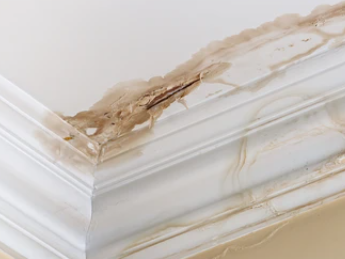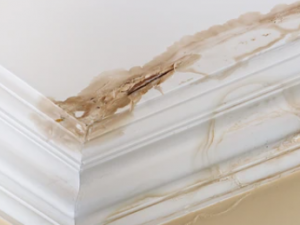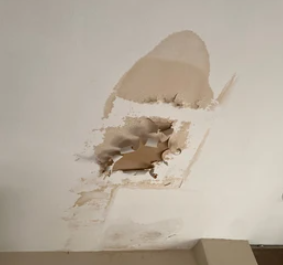Ceiling water damage should be swiftly repaired. Even a minor water leak can cause damage that is comparable to ruin from a major leak. Homeowners who promptly stop ceiling water damage will avoid spending thousands of dollars in repairs. Follow these steps to repair ceiling water damage.
Any of several scenarios can be responsible for ceiling water damage. Aging homes are notorious for cracks in the ceilings, which occur when the home settles and shifts. Cracks in the ceilings give water an opening through which to seep.
Similarly, structural damage, such as damaged ceiling joists, causes the home to shift; the resulting holes or cracks allow water inside. Roof leaks and plumbing leaks also cause water damage to ceilings. Clogged gutters and ice dams, too, can result in either a slow drip or overpowering gush of water.
1. Notice signs of ceiling water damage
Indications that a ceiling has sustained water damage are not always clear. The warning signs can be subtle. Early signs of water damage include visible stains. Ceiling water stains appear dark, rusty or yellowish—stains are the most recognized signs of water damage.
The ceiling paint also reveals when water damage has occurred. Peeling, flaking or cracking ceiling paint is caused by water damage. The paint may even appear to bubble. Homeowners might also notice that the baseboards or trim are separating from the ceiling.
A water damaged ceiling may develop cracks. Hairline cracks are not uncommon. The cracks can assume a spiderweb pattern or resemble a straight line. The entire ceiling can also sag and become bowed or swollen under the weight of water—even from a tiny water leak.
Accompanying most instances of water damage is mold growth. A water damaged ceiling will develop a nasty mold infestation, particularly along the corners. Mold colonies especially flourish when the room is humid. In cases of unaddressed ceiling water damage, mold will grow within 24 to 48 hours.
2. Locate the water source
Once ceiling water damage has been identified, pinpoint the source of the water damage. Homeowners should inspect the home, paying close attention to common problem areas, including the attic (where roof faults can lead to ceiling water damage). While in the attic, look for holes in the roof.
Water can enter through damaged siding or exterior walls. Plumbing fixtures with loose connections or ruptured pipes also force water inside. Water damage to the ceiling may occur when appliances, like the water heater or washing machine, spring a leak.
3. Mitigate the moisture damage
Turning off the water supply is the most immediate way to stop the spread of ceiling water damage. Homeowners might need to tighten loose hose connections or patch gaping holes using a putty knife, both of which can be performed independently and without professional help.
4. Dry the water damaged ceiling
A water damaged ceiling should be thoroughly dried once the leak is fixed. Air must circulate below and above the ceiling to eliminate moisture. Set up large fans and point them in the direction of the ceiling. Run the fans continuously to increase the rate at which the ceiling dries.
5. Remove damaged drywall
Remove water damaged ceiling drywall. Prior to starting this phase of the repair, place a drop cloth or tarp along the floor to catch bits of damaged ceiling debris as it crumbles. Wear safety goggles and a dust mask for protection while working.
Remove the damp sections of the ceiling. Homeowners will have little trouble executing this step, as wet drywall or plaster crumbles easily. Using a utility knife, cut away the damaged portions of the ceiling and leave the undamaged parts of the ceiling intact. Shallow cuts prevent stripping undamaged areas.
Bulging and loose parts of the ceiling must be removed. Use a paint scraper or taping knife to remove chipped or flaking surface areas. The ceiling drywall can be effectively removed by hand; alternately, homeowners may utilize handy tools, like a hammer, to complete the task.
6. Prep the surface of the ceiling
New sheets of drywall will fill large gaps in the ceiling. Joint compound or other sealant can be effectively used to fill small holes. A high viscosity sealant may be necessary, depending on the size of the gap. Sandpaper the corrugations between the damaged and undamaged parts of the ceiling.
7. Prime and paint the repaired ceiling
Priming and painting the ceiling are the last steps in repairing the water damaged ceiling. Apply the primer to the ceiling. Once it is completely dry, paint the ceiling. It is recommended that homeowners paint the entire ceiling, including unaffected areas, to ensure uniform coverage.
Water damage is an emergency situation, one that demands immediate attention. When you are faced with a water damage crisis of any type in your home or business, consult the area’s most dependable pros, ServiceMaster S&R Systems, for fast and efficient water damage restoration.
Any delays in responding to water damage can cause further ruin. As porous building materials absorb the moisture, the structural integrity of the property becomes increasingly compromised. Plus, mold growth will start within hours. Our technicians will promptly halt the spread of water damage.
Water damage mitigation technicians work quickly to remove standing water using advanced water extraction equipment. We set up powerful dehumidifiers to whisk away all remaining moisture. Affected goods undergo a full restoration or cleaning. Mold prevention services are offered, if needed.
ServiceMaster S&R Systems professionals also look for the source of water damage and take immediate steps to fix it. When water damage is extensive, such as the development of foundation problems, our reliable network of service providers will step in to repair the issue.
Home and business owners in Aurora, Naperville and Joliet, Illinois, and the surrounding communities have full confidence in the quality of services provided by ServiceMaster S&R Systems. We are available to respond to water damage crises right away. Call us for all your water damage restoration needs.



